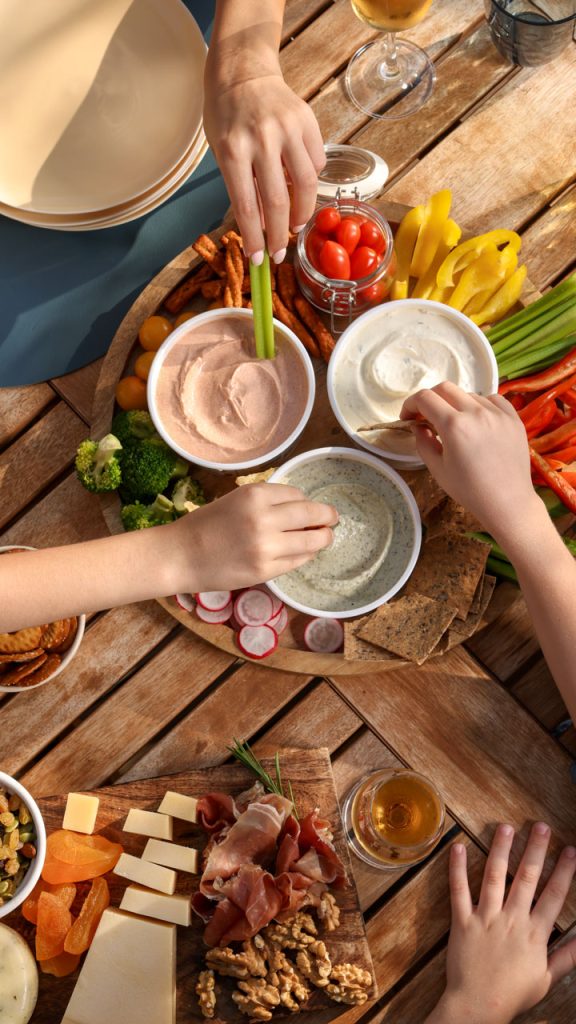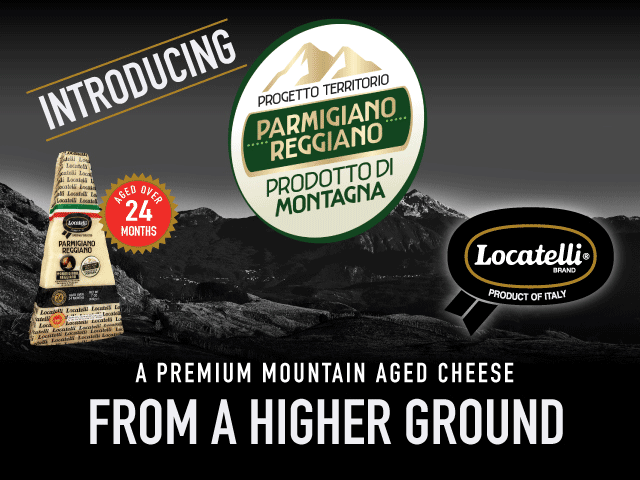Marketing Mediterranean in the Deli Department
May 20, 2025 | 6 min to read
The Mediterranean food segment is experiencing significant growth in supermarket delis, with revenue rising to $33.4 billion, driven by health-conscious eating and globally inspired flavors. As Monica Belsito emphasizes, items like hummus and feta cheese have gone mainstream. This diet promotes wellness through plant-based foods, and new products like Sabra’s Falafel Style Hummus and Grecian Delight’s ready-to-eat meats reflect innovative trends. The continued focus on convenience and sustainability is shaping packaging and merchandising strategies.

The Mediterranean segment continues expanding in delis due to healthful and flavorful options.
The Mediterranean food segment is in a growth trajectory, and this reveals great opportunity in supermarket delis.
Revenue grew at a compound annual growth rate of 3% to $33.4 billion over the last five years, including a rise of 0.2% in 2024, according to New York-based IBISWorld.
“Mediterranean inspired foods have continued to gain in popularity in the supermarket, with many now considered mainstream, including hummus, feta cheese, and even tabbouleh,” says Monica Belsito, chief marketing officer, Sabra Dipping Co., White Plains, NY.
Not only does this diet feature flavorful and diverse food, but it has long been touted as one of the healthiest diets.
“The Mediterranean diet emphasizes plant-based foods, including whole grains, beans, nuts and extra-virgin olive oil,” says Mike Paribello, senior vice president of marketing and retail sales for Grecian Delight | Kronos, Elk Grove Village, IL. “Popular in regions like Greece, Italy, Spain and Turkey, the traditional diet features a modest amount of lean poultry and plenty of seafood, focusing on overall diet quality, rather than specific nutrients.”
Rich in healthy fats, lean proteins, whole grains and fresh produce, it provides a way to promote overall wellness.
“The growing popularity of Mediterranean foods can be attributed to an increased consumer focus on health-conscious eating, a desire for globally inspired flavors and a rising preference for clean-label products made with high-quality ingredients,” says Aimee Tsakirellis, executive vice president, marketing at Cedar’s Foods, Haverhill, MA.
NEW DEVELOPMENTS
With today’s consumers seeking globally-inspired flavors, providers of Mediterranean foods are expanding their portfolios.
Sabra’s Falafel Style Hummus has bold flavor combinations of a stacked falafel platter with creamy, Mediterranean-inspired hummus.
Grecian Delight’s new launches include Opaa! Brand ReadyCarved Global Proteins in Old World Chicken Gyro, Pork Al Pastor and Halal Chicken Shawarma varieties.
“These meats come pre-marinated, pre-cooked and flame-broiled,” says Paribello. “Carved off-the-cone, they’re free from MSG and deliver ethnic flavors in minutes — simply heat and serve.”
The Opaa! Brand also offers Individually Wrapped Gyro Sandwiches & Gyro Kits, a Mediterranean Chicken Kit, and an Individually Wrapped Sandwich line.
Also new is Grecian Delight’s Garbanzees Chickpea Bites, which are made from chickpeas and a blend of vegetables, herbs and seasonings. Each fritter heats in minutes in an air fryer or oven and can be used in a wrap, on a salad or as an appetizer or snack.
Cedar’s Foods provides authentic, traditional flavors, such as Red Pepper Hommus and Cucumber Garlic Dill Tzatziki Dip.
“At the same time, we have embraced innovation, introducing bold new varieties, like Dark Chocolate Hommus and Dark Chocolate Cinnamon Hommus,” says Tsakirellis. “Cedar’s Spicy Pepper Feta Dip and Kalamata Olive Feta Dip showcase how we are experimenting with creamy, tangy and zesty profiles to keep Mediterranean flavors exciting.”

Atlanta, GA’s Yaza Foods offers labneh, a Greek yogurt version that is milk-based, strained with salt and over 2,000 years old.
“It’s very healthy, as labneh is high in protein and probiotics, yet low in fat and calories,” says Yaza Foods founder Karim Khalil. “Labneh is a staple in Lebanese cuisine that can be used in any meal, such as a rice bowl or as a naan or pita marinade.”
Introduced in April 2019, Hummus Goodness’ hummus lines contain no soybean oil for a clean label and fresh taste.
Founder of the Birmingham, MI-based company, Hannah Awada grew up in a Lebanese household and wanted to create a hummus like her mom used to make.
“We then started adding flavors, like beet, chili flakes, sriracha, roasted garlic and red pepper,” says Awada. “We also offer a pickle-flavored hummus and a taco flavor variety, as the majority of consumers gravitate toward flavors they know.”
According to Ehud Soriano, olive oil consultant and olive oil panel leader, Sindyanna of Galilee, Tel Aviv, Israel, since Mediterranean cuisine is based on simple, natural ingredients, it lends itself to creative and nutritious combinations. “Current trends focus on pairing sweet and savory elements, such as carob, date, grape or fig syrups, as well as chocolate infused with olive oil,” says Soriano. “These innovations challenge the dominance of ultra-processed foods by offering healthier, more nutritious alternatives.”
PACKAGING TRENDS
With so many new developments, there have been several packaging innovations in the Mediterranean food space.
“Sabra’s packaging was groundbreaking when first introduced because it allowed consumers to see the food they were buying, to appreciate the variety of flavors, as well as the visible mound of toppings,” says Belsito. “We also pioneered on-the-go options with our Snackers and continue to expand that line.”
Mediterranean foods are at the forefront of meeting consumer packaging preferences by offering convenient and practical solutions.
“Products are designed to be proportioned and easy to serve, ensuring a hassle-free experience,” says Paribello at Grecian Delight. “Easy-open packaging enhances accessibility, while resealable options help maintain freshness where applicable. Additionally, efforts are made to minimize excessive packaging, aligning with environmentally conscious consumer demands. Many packages also include preparation instructions and recipe suggestions, making it easier for consumers to enjoy Mediterranean cuisine at home.”
Additionally, snacking and grab-and-go options remain on trend as consumers increasingly seek convenient, on-the-go choices.
“Consumers are more aware of hummus and looking for larger sizes,” says Awada at Hummus Goodness. “We’re also seeing more of a demand for grab-and-go with 2-ounce containers.”
While packaging trends vary, Mediterranean foods offer a wide range of options to suit different needs, ranging from small 0.5L bottles to larger 5L tins of olive oil, as well as various sizes of cheese blocks, fermented or pickled vegetables.
Sindyanna of Galilee emphasizes the social impact of its products, adding an extra layer of value to Mediterranean foods.
“Our Fair Trade-certified products promote messages of peace, unity and solidarity,” says Soriano. “This philosophy is reflected in our olive oil labels, which feature names such as Extra Peaceful, Extra Social and Extra Unified.”
MARKETING & MERCHANDISING
There are several effective strategies to keep Mediterranean foods front and center in the deli.
“Retailers can introduce consumers to hummus by showcasing it with everyday snacking options, like pita chips, pretzels, marinated olives or feta cheese,” says Belsito at Sabra. “We also see retailers successfully highlighting Mediterranean foods in wellness-centric promotions or when spotlighting plant-based eating. Shelf blades, recipe cards and in-store demos can help introduce customers to products they have not yet tried.”
Mediterranean foods fit within existing footprints in the deli in the grab-and-go meals section, individual meals section and with deli packaged items.
“Delis are uniquely positioned to cross merchandise interdepartmental with items like gyro meat, hummus, tzatziki, pita bread and pita chips to make a meal out of individual components, but they can also offer these items in a deli prepared foods kit,” says Paribello at Grecian Delight.
Successful marketing strategies for Mediterranean foods include educational storytelling, sampling and ensuring products are easily accessible.
Khalil at Yaza Foods says the biggest challenge in marketing Mediterranean foods is education. “These foods are having a moment; people realize it’s a super food,” she notes. “We are doing a lot of in-store demos.”
Looking ahead, Belsito at Sabra anticipates the continued embrace of Mediterranean-inspired foods as people crave flavorful, healthy food that is good for the planet.
Soriano at Sindyanna of Galilee, agrees. “The Mediterranean Diet has been steadily gaining popularity for the past 30 years, and this trend is expected to continue as it reaches new markets and consumers,” he says. “Its appeal lies in its vibrant colors, simplicity, and the health benefits it delivers in every dish.”
13 of 17 article in DeliBusiness Summer 2025

